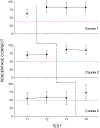Evaluation of a Computer-Based HIV Education Program for Adults Living with HIV
- PMID: 30929150
- PMCID: PMC6768760
- DOI: 10.1007/s10461-019-02474-z
Evaluation of a Computer-Based HIV Education Program for Adults Living with HIV
Abstract
This study evaluated a computer-delivered HIV and antiretroviral treatment education program in adults (N = 102) living with detectable HIV viral loads (> 200 copies/mL). The self-paced program provided immediate feedback for responses and financial incentives for responding correctly. The program was divided into three courses and a test of content from all three courses was delivered before and after participants completed each course. Test scores on the content delivered in Courses 1, 2 and 3 improved only after participants completed training on the relevant course. Initial test scores were positively correlated with health literacy and academic achievement; were negatively correlated with viral load; and were lowest for participants living in poverty. Education, academic achievement, and health literacy were related to how much participants learned following each course. Computer-based education is a convenient, effective approach to promoting an understanding of HIV and its treatment.
Keywords: Fluency training; Health education; Instructional technology; Medication adherence; Multiple-probe design.
Conflict of interest statement
All procedures performed in this study were approved by the Johns Hopkins School of Medicine Institutional Review Board. The authors have no conflicts of interest to report.
Figures


References
-
- Panel on Antiretroviral Guidelines for Adults and Adolescents. Guidelines for the Use of Antiretroviral Agents in Adults and Adolescents Living with HIV. Washington, DC: Department of Health and Human Services; 2017. Available at: http://www.aidsinfo.nih.gov/ContentFiles/AdultandAdolescentGL.pdf. Accessed June 30, 2018.
-
- World Health Organization; Consolidated Guidelines on the Use of Antiretroviral Drugs for Treating and Preventing HIV Infections: Recommendations for a Public Health Approach. 2nd ed Geneva, Switzerland: Author; 2016. Available at: http://www.who.int/hiv/pub/arv/arv-2016/en/. Accessed June 30, 2018. - PubMed
-
- Leone S, Gregis G, Quinzan G, et al. Causes of death and risk factors among HIV-infected persons in the HAART era: analysis of a large urban cohort. Infection. 2011;39(1):13–20. - PubMed
MeSH terms
Substances
Grants and funding
LinkOut - more resources
Full Text Sources
Medical

